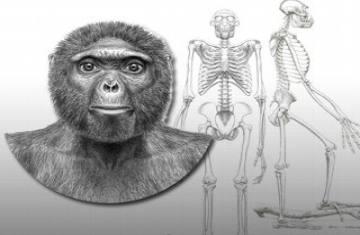
Above: Artist’s conception of “Ardi”, short for Ardipithecus
ramidus. Per WaPo: “shattered skeleton that an international
team of scientists believes is a major breakthrough in the study
of human origins.” Ardi lived 4.4 million years ago in Ethiopia
and a “key moment” in her discovery occurred on Nov. 5, 1994,
“when a Berkeley graduate student, Yohannes Haile-Selassie of
Ethiopia, found fragments of two finger bones.”
(J.H. Matternes/Science/ABC News Photo Illustration).
The New York Times
CONSIDERED | Art by Lou Beach
Published: October 4, 2009
The Hominid Sisterhood
Lucy, you sweet young thing. No longer can you lay claim to being the oldest creature on the human branch of the primate family tree.
The honor goes to Ardi, who at 4.4 million years old has you beat by a little over a million. Her assembled bones were unveiled Thursday by scientists who had been analyzing the Ardipithecus specimen since fragments were found in Ethiopia in 1992.
The particulars: Taller and heavier than Lucy, she weighed about 120 pounds and stood four feet tall (yes, she probably walked upright, though she was still an agile tree-climber). Forget the high heels; her feet had no arches (Lucy’s did). Tim D. White of Berkeley, a leader of the study team, said, “We are getting so close to that common ancestor of hominids and chimps, and we’d love to find an earlier skeleton.”
Read the rest of the Article »
Washington Post
By Joel Achenbach
Thursday, October 1, 2009;
“Ardi” is the nickname given to a remarkable, shattered skeleton that an international team of scientists believes is a major breakthrough in the study of human origins. The skeletal remains were painstakingly recovered from the Ethiopian desert along with bones from at least 35 other members of a species scientists call Ardipithecus ramidus. The 15-year investigation of Ardipithecus culminated Thursday in the publication of a raft of papers in the online edition of the journal Science, as well as dual press conferences in Washington and Addis Ababa, Ethiopia. “This is huge. This is the biggest discovery really since the ‘Lucy’ skeleton of the 1970s,” said Carol Ward, a University of Missouri paleoanthropologist who was not involved with the research but had been given a preview so that she could offer an independent assessment.
Watch: New revelations about humanity’s roots
Visit msnbc.com for Breaking News, World News, and News about the Economy
Related from Tadias: Ethiopia’s Priceless Treasures on Display in New York
Related Video: Selam, Lucy’s Baby
Paleoanthropologist Zeresenay Alemseged talks at TED
about finding the oldest skeleteon of a humanoid child.


























As a student of Anthropology I am naturally exited by new findings. This is big news with global implication that adds new evidence to our understanding of how we came to be as a human race. I can’t help but chuckle though whenever I remember my elderly aunt, visiting from Ethiopia, once intently heard my cousin and I discussing this very same topic. She interrupted the conversation to offer her opinion and expressed her grave concern that she has “big doubts” about what they teach us in school. “I don’t know about you people”, she warned. “But I am descended from no monkey. I am created by God and I am a decedent of Adam and Eve. End of story.”